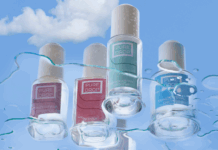In both the food and cosmetics sectors, recent innovations are often based on these products. In the cosmetics department, you'll find shaving and styling foams, shampoos and bubble baths, skincare creams and other make-up products. Increasingly, all are available in foam, emulsion or emulsion foam form.
Matter in all its states
But what exactly is foam? Technically, a foam is obtained by dispersing a volume of gas (usually large) in a volume of liquid (usually smaller). Similarly, an emulsion is the result of dispersing a liquid (often oil) in another non-miscible liquid (often water). In parallel, surfactants or other stabilizing agents (polymers, proteins, solid particles, etc.) need to be added to give these dispersions a sufficiently long life. The science of foams and emulsions lies precisely between physics and chemistry, with formulation playing a major role in establishing the key mechanisms for achieving the optimum shelf life for an application.
Unique properties for cosmetic applications
The appeal of these dispersions - foams and emulsions - lies in the fact that their properties are unique and very different from those that would be obtained using simple liquid solutions alone. This is particularly striking when it comes to the mechanical (or rheological) properties that characterize the texture of the product: by converting to foam or emulsion form, we can obtain an original material with both solid and liquid behavior, which we describe as viscoelastic and which will depend on the stress applied, i.e. the way in which it is used. In this way, the finished product can be held in the hand without flowing, but also spread easily during application.

This intermediary behavior between solid and liquid plays a fundamental role in the sensory perception of the product. Understanding and mastering these sensory aspects is where many of the challenges in innovation lie. Finally, foams and emulsions enable active ingredients to be compartmentalized: lipophilic compounds, for example, can be confined within oil droplets. This compartmentalization enables these agents to be protected over time, then re-injected during use.
Research to understand and innovate
However, despite the large number of products already on the market, certain mysteries still surround the science of foams and emulsions. In particular, the dependence of stability on formulation often remains to be understood. In the current context, there is a strong demand to reduce the number of chemical ingredients in these formulations and to replace them with "greener" ingredients. To innovate in these areas, it is crucial to understand how they work. In addition, current research is seeking to broaden the range of possible foam and emulsion-based materials: more understanding of emulsion foams, gelled foams and emulsions, non-aqueous foams or "water-in-water" dispersions will enable us to move towards new applications.
To help with these various developments, CNRS Formation Entreprisethe CNRS's continuing education organization, is offering a a course designed to pass on current knowledge about foams and emulsions for a non-expert audience. The course is organized at the Institut Charles Sadron in Strasbourg by Wiebke Drenckhan, CNRS Research Director, winner of the CNRS Bronze Medal in 2015 and the Mediation Medal in 2023, as well as the Irène Joliot-Curie Prize for Young Woman Scientist of the Year in 2013, and Arnaud Saint-Jalmes, CNRS Research Director at the Institut de Physique de Rennes, where he has been Deputy Director for the last five years. The two researchers, who have over 25 years' expertise in the field of foams and emulsions, regularly work with companies to support their innovation initiatives.
The central aim of the course is to develop the right reactions and reflexes for dealing with problems involving foams and emulsions. The aim is to acquire a global, multi-scale vision of this field, in order to understand the relationship between physical and chemical parameters in these materials. The program focuses on the acquisition of fundamental physico-chemical notions on the manufacture of foams and emulsions, their structure, their stability over time and their macroscopic properties. The course relies heavily on experimental sessions, enabling students to discover different characterization techniques.
Liquid foams and emulsions: generation, stability and propertiesfrom May 14 to 16, 2024, a training course offered by CNRS Formation Entreprises.








